Alienware M14x: the Sound and the Fury
by Dustin Sklavos on July 19, 2011 12:35 AM ESTApplication and Futuremark Performance
At this point the Intel Core i7-2630QM at the center of the Alienware M14x is largely a known quantity, but in the 14" notebook class things are different, with quad-core processors being more rarefied. Most of our 14" notebook reviews are from the Arrandale era, but we do have a couple of Sandy Bridge notebooks thrown into the mix to give you an idea of how performance has changed, and we've also got the sample AMD Llano A8 system.


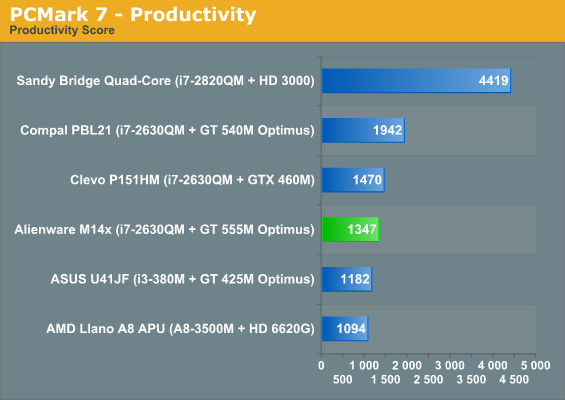

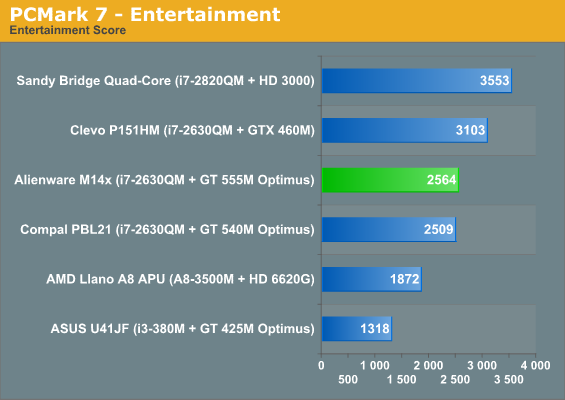
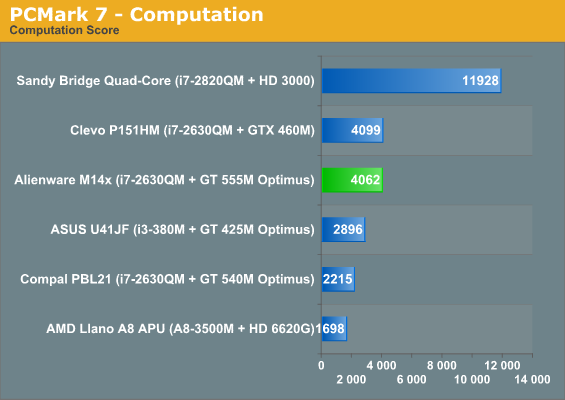
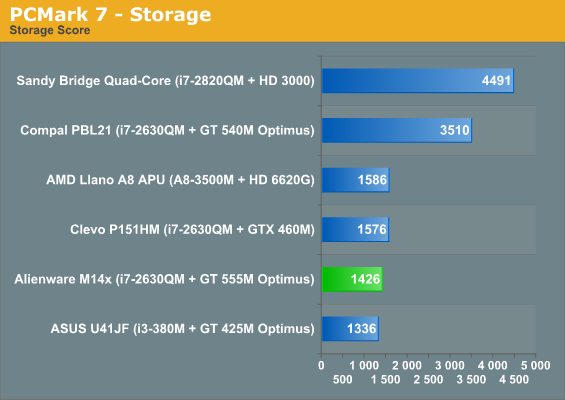
Where possible the SSD-equipped Compal PBL21 and Sandy Bridge quad-core reference system get a comfortable lead, proving that PCMark still skews heavily towards SSDs even in its most recent version. The storage benchmark is particularly brutal, suggesting the Samsung hard drive the M14x ships with may not be as fast as its counterparts from Seagate and Western Digital. Overall, though, the M14x hangs out in the middle of the pack, about where it ought to be.
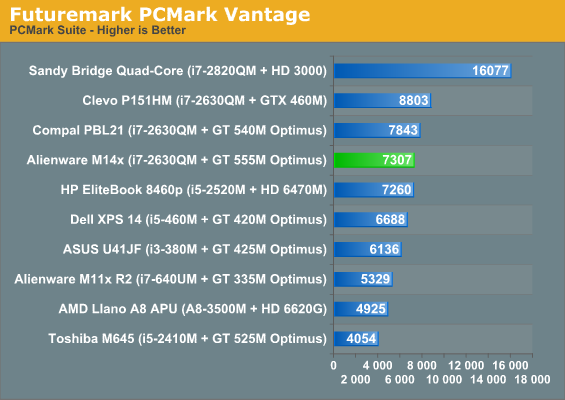
For some reason, PCMark Vantage doesn't favor the SSD-equipped Compal PBL21 as heavily in our lineup, while Sandy Bridge continues to be a monster, both as a processor and as a reference platform.
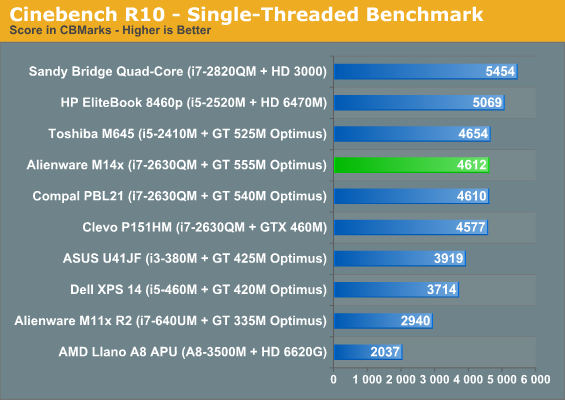
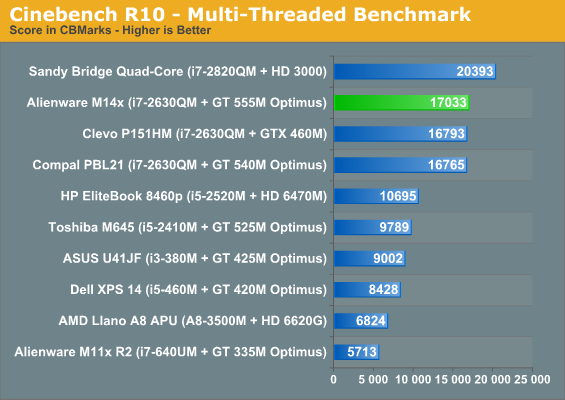
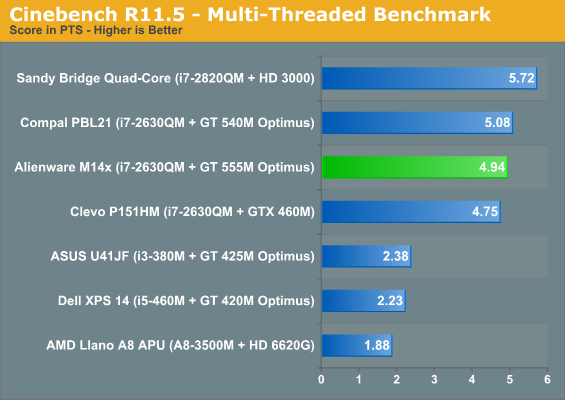
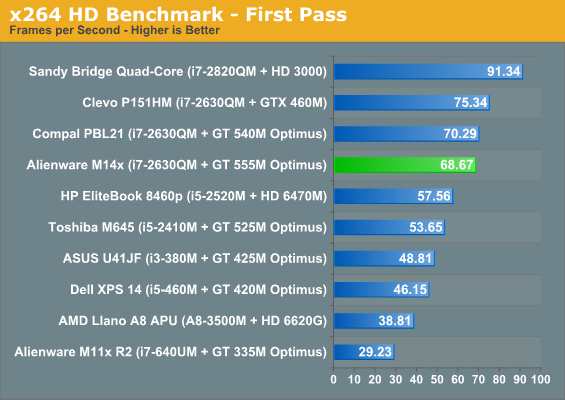
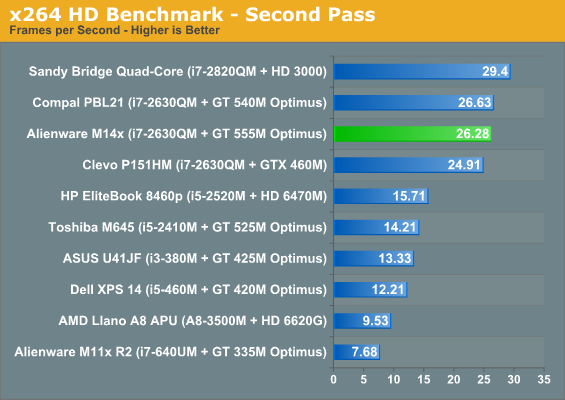
The beauty of Cinebench is how repeatable and consistent its test results are, and the Alienware M14x falls in exactly where it ought to be. Our x264 encoding test tells much the same story, one you already knew: the i7-2630QM is mighty fast. Where things get interesting is when you look at how much of a performance boost the i7-2630QM brings for the M14x against competing 14" notebooks that are only able to leverage dual-core processors. While Arrandale and Clarksfield would often compete directly against each other, Sandy Bridge quad-cores produce a clear and consistent performance advantage over their dual-core counterparts.
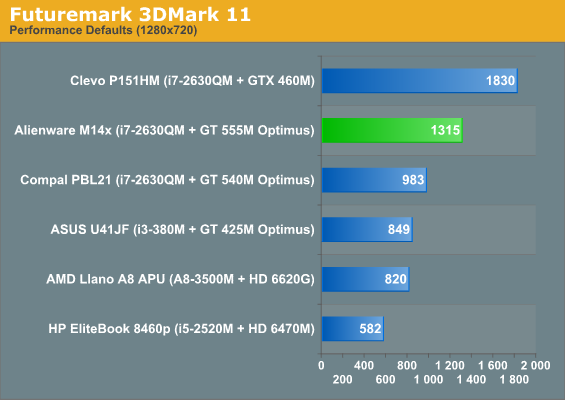
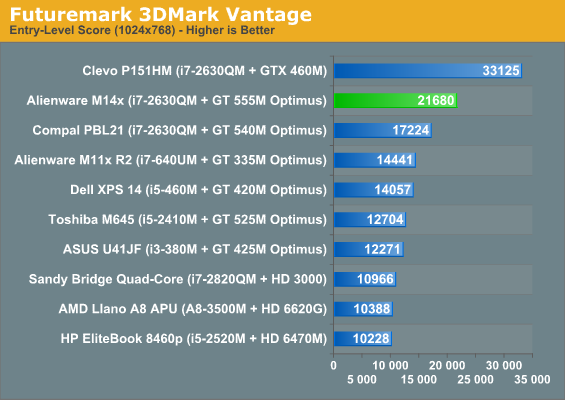
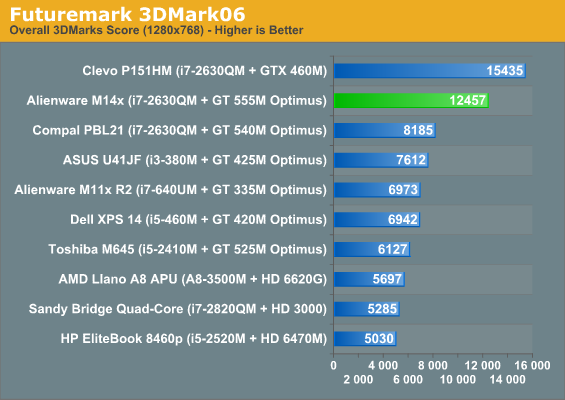
Finally in 3DMark, the 144-shader NVIDIA GeForce GT 555M offers a substantial performance improvement over the 96-shader GT 540M and its kin, bested only by the more powerful GTX 460M. Keep in mind the form factor that the GT 555M is residing in, because this is pretty much the fastest chip you can conceivably fit in a 14" laptop.










48 Comments
View All Comments
JarredWalton - Tuesday, July 19, 2011 - link
I agree with you on high-DPI being a problem for those of us with less than perfect eyesight (welcome to the world of 35+ year olds!), but the 1366x768 resolution itself is still an eyesore in the sense of being a pain to use. Windows is really targeted at higher resolution displays, and 16:9 widescreen didn't help the situation. I'd much rather have 1440x900 or 1680x1050 (or 1920x1280 or even 1280x800) than all the 16:9 stuff. 768 vertical pixels just doesn't cut it for me; just like 1024x768 went out of fashion about six years back, a wider version of 1024x768 isn't any better. Your 1280x1024 desktop display is a relief in more way than one I'm sure!Incidentally, I use a 30" desktop LCD at 2560x1600, and I have to set the DPI to 120 in Windows and deal with the various programs that don't work right with font scaling in order to use the LCD without eyestrain. And yet, given the choice, I still wouldn't go back to a lower resolution, lower DPI panel. It's the proverbial Catch-22: I need the higher resolution, but the higher DPI is difficult to see, but you can't get high resolution and low DPI unless you're running a 40+ inch HDTV. (And running a 30" LCD at 1920x1200 results in scaling blurriness, so I prefer to deal with the Windows DPI crud.)
FH123 - Tuesday, July 19, 2011 - link
I can't really argue with that. We're basically on the same page - and I'm 46 - although I do tilt the other way and use my 8-year old XGA laptop screen most often. I like working with the machine on my lap.Age makes you cynical about progress. I recently evaluated a Thinkpad X220 with a great IPS screen, but quite high DPI at 12.5" and with 1366x768 16:9 resolution. The perfect example of the schizophrenic nature of progress, it also took 90 seconds to fully boot Windows 7 from a conventional disk. My 8-year old Northwood P4 (Thinkpad T30) boots XP in less than 1 minute including a virus scanner and full-disk encryption (also no SSD). Would I feel the benefit of SandyBridge if I moved on to it? Probably, but my old machine is surprisingly easy to live with. There are too many things, like boot / load times, that are not improved even with SSDs, for example Thinkpad applets and the Intel display driver UI that I suspect are written in .NET. There are others, like ever shallower keyboards and less-tall, low contrast screens, that are in fact regressing. Among screens today a 14" 1280x800 screen would possibly be ideal for me ... if it still existed.
JarredWalton - Tuesday, July 19, 2011 - link
At CES 2011, Lenovo was demoing a ThinkPad Edge that could boot in under 10 seconds. Now *that* is a laptop I'd like to fool around with -- I was very curious what sort of tweaks they had made to get it to boot that quickly. Obviously there was no bloatware, but even so my desktop with an overclocked i7-965 and Vertex 2 SSD takes about 12 seconds to boot Win7, and that's not including the 15 seconds it takes to POST.FH123 - Tuesday, July 19, 2011 - link
Yeah, this is why the X220 being so slow surprised me. I'm sure it had the "Lenovo Enhanced Experience" sticker, which I thought is partly about quick boot time. An SSD would have made a huge difference of course, but even so. Then, once you start using some of the Lenovo apps to, say, adjust your power management settings (on a Thinkpad T410s WITH AN SSD that I have), they can take ages to come up, i.e. several seconds. In my view applets like that should open up instantly. Lenovo Enhanced Experience is a mixture of the good and the awful. It possibly comes down to some manager not seeing that they can't write this stuff completely in .NET, Flash, Java or whatever they're using.There's a video on YouTube somewhere where Lenovo explain how they worked quite deeply with device driver manfuacturers to cut down the boot time. Of course they don't say exactly what they did and you can supposedly only reap the benefit from their preload. Based on my extremely limited experience I have to wonder whether that only works well on select demo machines. It must be hard rolling out the performance tweaks across every driver and BIOS revision.
sir_laser - Tuesday, July 19, 2011 - link
Shoutouts to Faulkner and Shakespeare!FH123: So what you are saying, in part, is that it is very difficult to find high quality low DPI laptop screens in the consumer market?
FH123 - Tuesday, July 19, 2011 - link
I must confess I haven't looked at the consumer market. I buy business laptops, usually Thinkpads for their keyboards. I have the impression that complaints about poor screens are universal though and have more to do with the manufacture and availability of those screens. There seem to be some markets where high quality screens are more common, e.g. tablets, workstation and large high-end laptops - as well as anything made by Apple. However try to find a decent screen in a mainstream 14" Windows laptop and the situation is dire.Beenthere - Tuesday, July 19, 2011 - link
...but refuse to buy it with an Intel CPU. Alienware told me they do not know if or when they will be using Llano APUs but this would seem like a smart move for good gaming performance with low power consumption and low heat/fan noise.JarredWalton - Tuesday, July 19, 2011 - link
Ah, yes, the anti-Intel sentiment. Unfortunately, as an enthusiast company, there's really no place for Llano in Alienware's current lineup. The ULV processors used in the M11x are generally equal to Llano in terms of power use for idle/low use, equal in multi-threaded performance, and much faster in single-threaded performance.Llano A8-3800M vs. M11x R3:
http://www.anandtech.com/bench/Product/385?vs=396
Llano A8-3800M+6630M vs. M11x R3:
http://www.anandtech.com/bench/Product/386?vs=396
Beenthere - Tuesday, July 19, 2011 - link
So Alienware loses another sale. In this economy it's gotta hurt to not be selling what consumers want.cjl - Tuesday, July 19, 2011 - link
You know, I believe the evidence is that consumers want performance and battery life, and by and large, they don't really care what brand of processor the computer has. Those that do mainly prefer intel (thanks to their advertising). So, I would say that Alienware is selling exactly what consumers want.